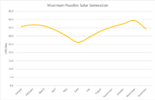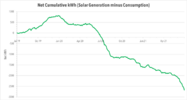It's a cold, wet weekend here in locked-down Sydney, so what else better to do than
over-post in the Tesla forum and crunch some PW2 stats?
I now have 2 years worth of 5 minute data - 210,516 rows.
Over that time, my modest 5.84 kW array has generated a total of 15.56 MWh or 21.3 kWh/day. It generated a fair bit more in Year 1 (8.06 MWh) than Year 2 (7.50 MWh) which has been cloudier. This has not been enough to power my house (including EVs) which on average consumed 25.0 kWh/day. The power flows have been:
- Solar to House: 7.1 kWh/day
- Solar to Battery: 8.4 kWh/day
- Solar to Grid: 5.8 kWh/day
- Grid to Home: 10.1 kWh/day
- Grid to Battery: 0.5 kWh/day
- Battery to Home: 7.8 kWh/day
- Battery to Grid: 0.0 kWh/day
So the value of the battery is clear - without it, 7.8 kWh of stored solar power per day would instead have come from the grid, beating the 7.1 kWh/day of solar that is used directly. The other benefit is enabling time-shifting of grid consumption:
- Peak: 0.7 kWh/day (6.2%)
- Shoulder: 2.6 kWh/day (24.6%)
- Offpeak: 7.3 kWh/day (69.2%)
I draw nothing from the grid 67.7% of the time. The battery spends 18.7% of its time full and 22.8% of its time at minimum level (10%). My self-powered percentage is a slightly disappointing 59.5% but I can't fit any more panels on my roof. The most solar ever generated in a day was 36.01 kWh and the least 0.87 kWh.
Based on the data, I calculate the PV array+inverter efficiency to be 95.0% and battery roundtrip efficiency to be 93.7%.
Finally a couple of interesting charts. The first one shows how much solar my array could generate if there was never a cloud in the sky. This is calculated by finding the maximum generation ever recorded in every time-consistent 5-minute period in a given week over the past 2 years. It adds up to 12.4 MWh per year, so my array has generated 62.7% of that. Or one could say the "cloud factor" in Sydney, based on this, is 37%. So if it was never cloudy I would be able to fully power my house from solar.
View attachment 683144
The next is the cumulative net position of solar generation minus consumption. After a glorious initial 10 months when I was well and truly in the black, it's gone south ever since May 2020. I put this down mostly to working from home since the pandemic hit, as well as increased consumption after getting my Model 3 in December 2019.
View attachment 683145




